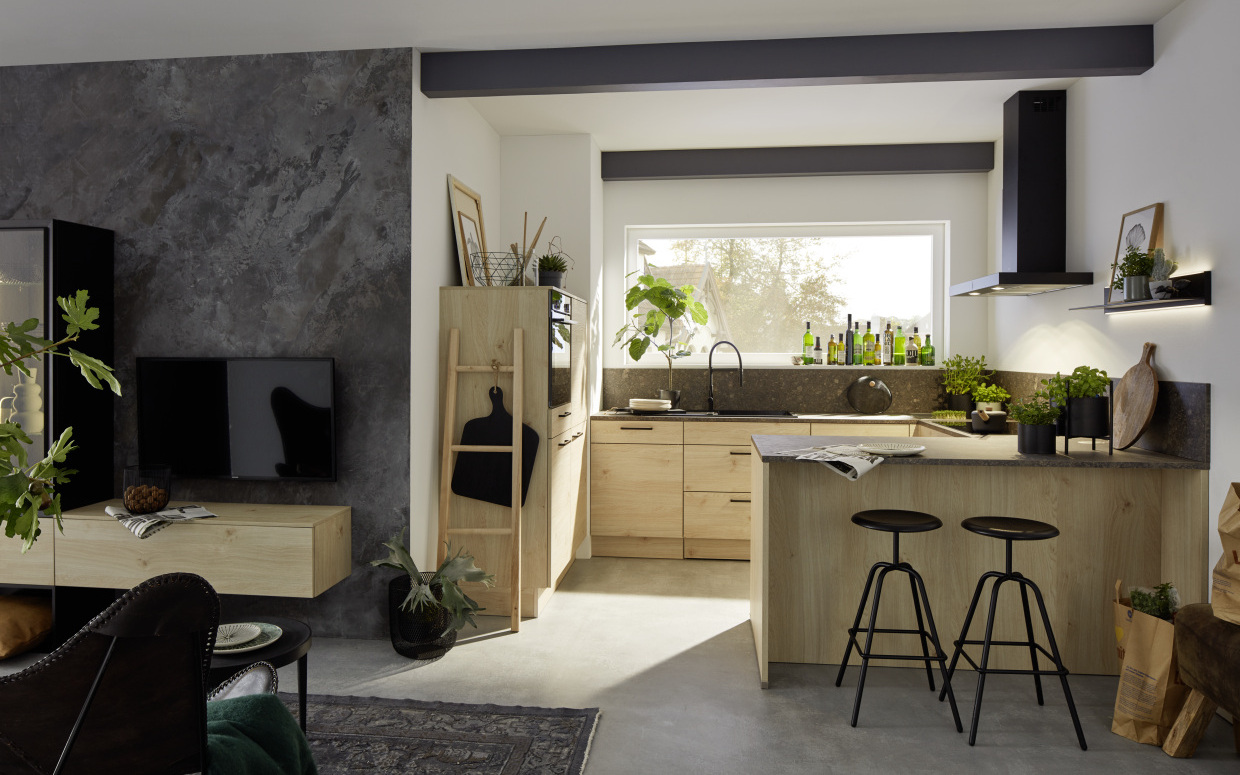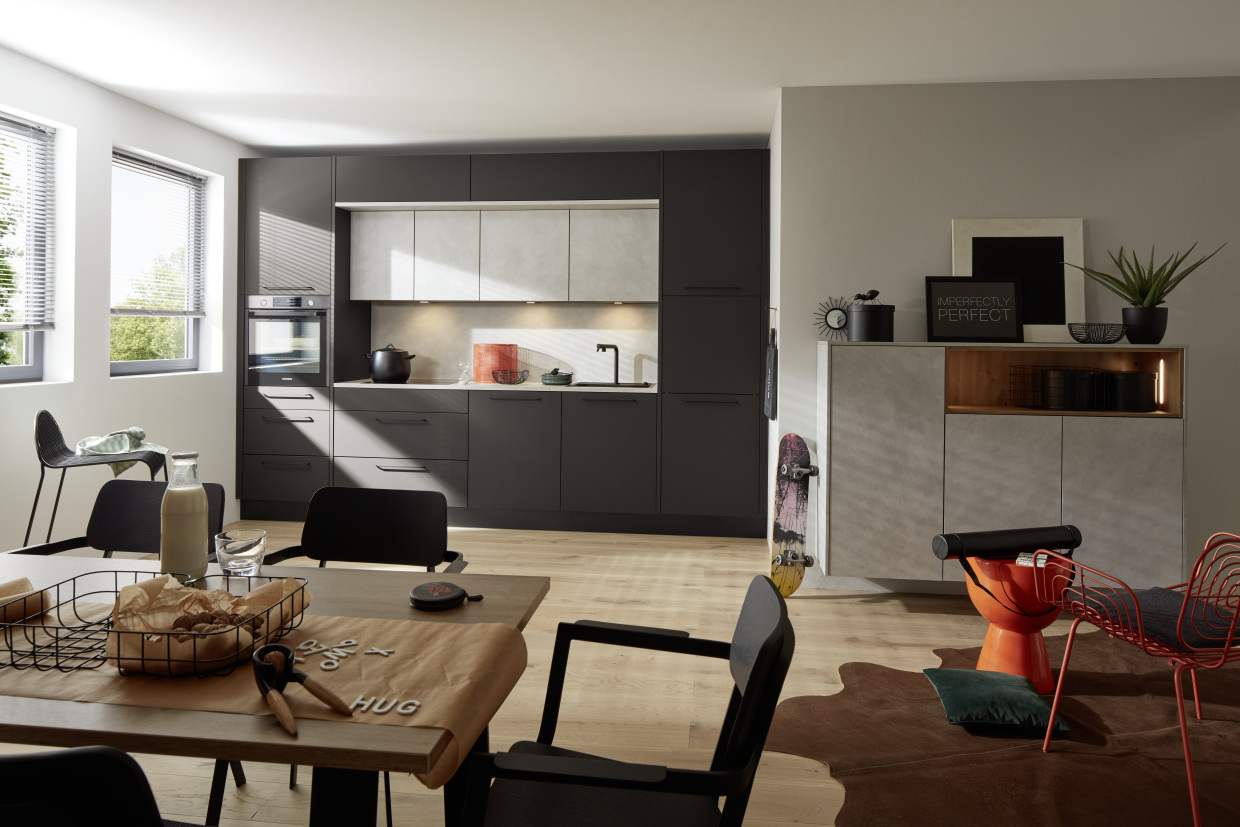
The perfect kitchen should not only be a feast for the eyes, but also offer the best possible work conditions. Ideally, the functional areas for cooking, washing up and storage are planned in the form of a triangle. As a rule of thumb, the distance between the areas should be twice the arm's length.
The conditions of the room determine the position of the triangle in the specific case and if the triangle can be realised at all. Perfect kitchen planning also takes into account the needs of its users, their cooking and living habits as well as the storage space required. The aim should be to make the best possible use of the available space and - if possible - to arrange it in a homely way. There are different kitchen shapes for this.
The kitchenette
The kitchenette is ideal for single households and small, narrow rooms. It should be at least three metres long to integrate all relevant functions on the long side. To get the maximum of precious storage space, tall and wall cabinets should also be included. Extra tip: Use the plinth area as well! Special drawers and pull-outs are available for this purpose. The kitchenette is by comparison the cheapest option for creating a simple and functional kitchen. However, it offers only a relatively small worktop surface and the workspace is limited. It is therefore particularly important to check the requirements that the room shouldat least fulfil carefully.

Double-linear kitchen
If you haveat least 8 square metres available, it becomes more comfortable. Here you canplan a second row. The distance between the cabinets facing each other shouldbe at least 120 centimetres. This ensures that you can open pull-outs and doorseasily and that they do not get in each other's way. In double linear kitchens, you should plan wall cabinets or tall cabinets on one side only. Otherwise,the whole kitchen will quickly look too massive.

L-shape kitchen
Alternatively, and where appropriate, the cabinets can be arranged around corners. The advantage of such an L-shaped kitchen is that it fits into almost any medium-sized room and is a perfect match for the “work triangle”. In open-plan designs, the L-shape can take on the function of a room divider if you plan one freestanding side. If at least 12 square metres are available, it is also easier to integrate a dining area. In any case, it is important that you do not waste the space in the corner. Depending on the position of the connections, you can think about a matching sink. Alternatively, you can choose a cabinet that makes efficient and ergonomic use of the angle, for example the “Le Mans”. By the way, this also applies to the following kitchens with U- or G-shape.

The U-shape
The U-shape is ideal for squared rooms from about 10 m² upwards. It is perfect for ergonomic work with short distances. For this purpose, there should be at least 120 centimetres of space between the rows that face each other. In other words, the minimum room width should be 2.40 metres, preferably three metres. Apart from this, there are numerous planning options. In open-plan rooms, you can use a U-shape to create a spacious kitchen-living room combination, for example. The freestanding side is ideal for a dining area or a counter. This planning looks homogeneous and self-contained, almost like a room within a room, but at the same time inviting and communicative. Our tip for more comfort: The U-shape offers plenty of storage space with many base units. You should therefore only plan tall cupboards on one side. You may also be careful with wall units to avoid overloading the room. Especially with open floor plans, homely transitions are important, for example using illuminated glass door cabinets or open shelves.

G-shape kitchen
A special form of the U kitchen is the G-shape kitchen. Here, you have an additional short line running inwards, which is ideal for a dining area, for example. A G-shape requires a lot of space and is perfect for family kitchens as well as for cooking together in large, preferably open spaces. The prerequisite, as with the U kitchen, is that there is enough free wall space without doors.

Kitchen Island
With at least 15 square metres, islands require the most space. For ideal traffic lines, they need at least 80 centimetres all around. If you connect the cabinets to a wall as a "peninsula", the space requirement is a little smaller. In open-plan kitchens, islands are a beautiful and practical eye-catcher. They can be combined with other kitchen shapes, for example with a linear kitchen. In this case, a minimum distance of 120 centimetres is also required. Just as with the freestanding units in a G or U kitchen, the same applies here: If you want to place the hob in the island, for example - which is very communicative – you have to plan the corresponding connections accordingly. Please also think about the extractor fan, for example in the form of a downdraft extractor, and do not forget the lighting!

We wish you a lot of fun designing your kitchen!